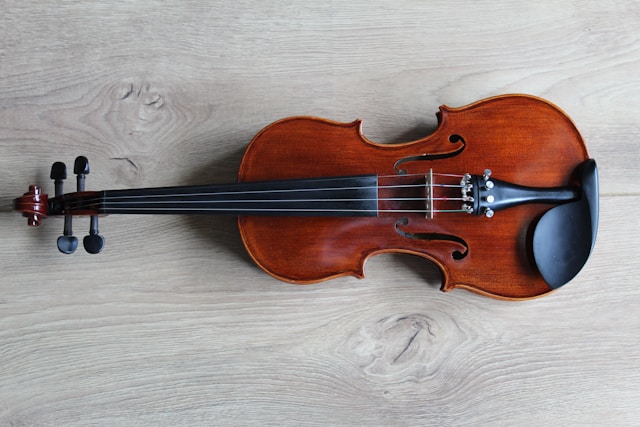
The violin, with its rich history and beautiful sound, is a beloved instrument worldwide. It is known for its versatility, being used in a variety of music genres, from classical to folk. However, the path to mastering the violin is not easy. Understanding the learning curve is crucial for anyone embarking on this journey.
This guide aims to set realistic expectations for beginners, offering a comprehensive overview of the challenges and the rewards that come with learning to play the violin.
Why Play Violin?
Playing the violin offers numerous benefits, including improved cognitive skills like memory and concentration, which can positively impact academic performance. It enhances fine motor skills and hand-eye coordination through precise finger movements and bowing techniques. Violin practice fosters discipline and patience, as mastering the instrument requires consistent effort and perseverance. Additionally, playing the violin provides a creative outlet.
Beginners should choose the right equipment for a positive learning experience. Prier Violins emphasizes the importance of selecting a suitable bow, as it affects sound quality and playability. A properly sized violin, comfortable shoulder rest, and high-quality strings also enhance the ease of playing and sound production. Additionally, beginners should be patient, practice consistently, and seek guidance from a skilled teacher to develop proper techniques and avoid bad habits.
Difficulty Level Explained
Learning to play the violin is often considered quite challenging, and on a difficulty scale from 0 to 10, it would likely be rated around 8. Here are some factors contributing to this rating:
- Posture and Technique: Proper posture, hand position, and bowing technique are crucial and require a lot of practice to master.
- Intonation: Unlike fretted instruments, violins have no markings to indicate where to place fingers, so learning to play in tune is particularly difficult.
- Coordination: Playing the violin requires precise coordination between the left hand (for fingering) and the right hand (for bowing).
- Ear Training: Developing a good ear for music and being able to recognize when notes are in or out of tune is essential.
- Repertoire: The violin repertoire includes complex pieces that often require advanced techniques.
How Long to Learn Violin
This varies widely depending on several factors, including the frequency and quality of practice, individual aptitude, and instruction quality. Generally:
- Basic Skills: With regular practice (about 30 minutes a day), you’ll be able to play simple tunes within 6 months to a year.
- Intermediate Level: Reaching this level, where you can play a wider range of pieces with better intonation and technique, typically takes two to three years of consistent practice.
- Advanced Level: You can perform complex repertoire with a high degree of proficiency, usually requiring 5 to 10 years of dedicated practice.
This timeline assumes regular lessons with a skilled instructor and consistent, focused practice.
The Challenges of Learning the Violin
Set realistic expectations and prepare yourself for the dedication and persistence required to master the instrument.
Physical Challenges
- Posture and Holding the Violin: Beginners often find it hard to maintain this posture for a long time. To stay comfortable and prevent injuries, it’s important to sit or stand correctly when playing the violin. Hold the violin at the right angle, keeping your back straight, and placing your left hand properly on the neck of the violin.
- Finger Placement and Dexterity: Unlike instruments with frets or keys, the violin needs exact finger placement on the fingerboard. For beginners, learning to move their left hand fingers quickly and accurately is a big challenge.
- Bowing Technique: To make a good sound on the violin, you need to hold the bow correctly, apply the right amount of pressure, and move it smoothly with your right hand and arm. Beginners often find it hard to coordinate their bowing hand with their fingers on the violin, which can lead to uneven or scratchy sounds.
Mental Challenges
- Reading Sheet Music: Learning to read sheet music is essential for violinists. It means understanding symbols, rhythms, and instructions. For beginners with no musical experience, this can be overwhelming because they need to recognize and interpret notes, rests, dynamics, and other markings. They also need to quickly translate the written music into finger placements and bowing techniques on the violin.
- Understanding Music Theory: Knowing music theory helps violinists understand how music is put together, like learning about scales, chords, and key signatures. Music theory can be complicated, with many ideas to learn and use. Beginners often struggle to see how this knowledge applies to actually playing the violin, making it challenging to use in their practice and performance.
- Developing Listening Skills: Good listening skills are essential for violinists to play well. They need to hear and fix their pitch, rhythm, and dynamics, which means paying close attention and assessing their playing. For beginners, it can be hard to notice small differences in sound and make quick adjustments. This skill is crucial for playing in tune and keeping the right rhythm, which improves the overall quality of their music.
Emotional Challenges
- Dealing with Frustration: Learning the violin can be frustrating. Progress might seem slow, and mastering even simple pieces can take a long time. This can lead to feelings of discouragement.
- Staying Motivated: Maintaining motivation over the long term is essential. Many beginners start with enthusiasm but struggle to keep it up when they encounter difficulties.
- Managing Performance Anxiety: Playing in front of others can be nerve-wracking, especially for beginners. Performance anxiety can affect one’s ability to play well and enjoy the experience.
The Learning Process
The process of learning violin lies in its ability to build a strong foundation of skills and knowledge, fostering long-term success and mastery.
Initial Stages
- Choosing the Right Violin: Selecting a suitable violin is crucial for beginners. The size of the violin should match the player’s body size, and it should be of good quality to produce a decent sound. Consulting a teacher or a knowledgeable salesperson can help in making the right choice.
- Basic Exercises and Routines: Beginners start with basic exercises to build fundamental skills. This includes simple finger exercises, basic bowing patterns, and scales. These exercises help in developing muscle memory and coordination.
- Importance of a Good Teacher or Tutor: A qualified teacher can provide personalized guidance and feedback, making the learning process more effective. They can help beginners avoid bad habits and ensure they are progressing correctly.
A good tutor should be patient, encouraging, and adaptable to the student’s needs and goals. They should provide a structured yet flexible curriculum and foster a positive student-teacher relationship to enhance motivation and enjoyment. Consider the tutor’s availability and location for consistent lessons, and take advantage of trial lessons to assess compatibility before committing.
Intermediate Stages
- Developing Technique and Muscle Memory: As beginners progress, they focus on refining their technique and building muscle memory. This involves more complex exercises, scales, and arpeggios. Consistent practice helps in internalizing these techniques.
- Expanding Repertoire: Intermediate learners start to expand their repertoire, playing more challenging pieces. This exposes them to different styles and genres of music, enhancing their overall musicality.
- Introduction to Different Styles of Music: At this stage, learners might explore various styles such as classical, jazz, folk, or contemporary music. This broadens their skills and keeps their practice sessions interesting.
Advanced Stages
- Mastering Complex Pieces: Advanced learners tackle complex and demanding pieces that require high levels of technical skill and musical expression. This includes solo pieces, concertos, and sonatas.
- Playing in Ensembles or Orchestras: Playing with others in ensembles or orchestras helps in developing ensemble skills such as listening, blending, and following a conductor. It also provides valuable performance experience.
- Preparing for Performances and Exams: Advanced learners might prepare for recitals, competitions, or music exams. This involves focused practice, memorization, and dealing with performance pressure.
Tips for Effective Learning
The following learning tips are essential as they equip individuals with strategies to maximize their study time and retain information more efficiently.
Consistent Practice Routines
Consistency is key in learning the violin. Regular practice, even if it’s just for a short time each day, is more effective than infrequent, long practice sessions. Establishing a routine helps in building discipline and steady progress.
Setting Achievable Goals
Setting realistic and achievable goals keeps learners motivated. Breaking down long-term goals into smaller, manageable tasks makes the learning process less overwhelming and more rewarding.
Utilizing Technology and Resources
There are numerous online tutorials and apps available that can supplement traditional lessons. These resources provide additional exercises, tips, and interactive tools to enhance learning. Moreover, using practice aids like metronomes and tuners helps in developing timing and intonation. These tools are essential for effective practice.
Seeking Feedback and Mentorship
Constructive feedback from teachers, peers, or experienced musicians is invaluable. It helps learners identify areas for improvement and provides encouragement. Mentorship can also offer guidance and inspiration.
Active Listening and Engagement
Active listening during lessons and practice sessions is crucial. This means fully concentrating, understanding, responding, and remembering what is being taught. Engaging with the material actively, such as by asking questions, participating in discussions, and taking notes, helps reinforce learning and aids in better retention of information.
Balanced Practice Techniques
Incorporating a variety of practice techniques can prevent monotony and target different skill areas. This includes slow practice for precision, playing along with recordings to develop a sense of timing and style, and performing in front of others to build confidence. Balancing different types of practice helps in developing a well-rounded skill set.
Common Mistakes and How to Avoid Them
Navigate potential pitfalls to ensure a smoother and more efficient learning journey for a more positive, rewarding experience.
- Poor Practice Habits
Effective practice involves focusing on quality rather than quantity. It’s important to practice slowly and accurately rather than rushing through pieces. Taking breaks to avoid fatigue and maintaining concentration is also crucial.
- Neglecting Music Theory
Music theory is the foundation of understanding how music works. Neglecting it can limit a learner’s ability to interpret and perform music effectively. Incorporating theory study into practice routines is essential.
- Overlooking the Importance of Listening
Listening to recordings of great violinists and different music styles enhances musicality. It helps learners develop a sense of phrasing, dynamics, and expression. Active listening should be a regular part of practice.
- Failing to Address Physical Discomfort
Playing the violin should not cause pain. It’s important to address any physical discomfort immediately. This might involve adjusting posture, taking breaks, or consulting a teacher for advice. Ignoring discomfort can lead to musculoskeletal injuries.
Staying Motivated
Learning the violin is challenging due to its steep learning curve, requiring consistent practice and patience to see significant progress. The initial stages can be frustrating, with students often struggling to produce a pleasant sound, leading to discouragement. Balancing practice with other commitments and overcoming physical discomfort or fatigue can further hinder motivation.
- Finding Joy in the Learning Process
Enjoying the learning process is crucial for long-term motivation. Celebrating small successes and finding pleasure in daily practice helps in maintaining a positive attitude.
- Joining a Community of Learners
Joining a community of violin learners, whether online or in person, provides support and encouragement. It offers opportunities to share experiences, ask questions, and perform together.
- Celebrating Small Victories
Acknowledging and celebrating small achievements keeps motivation high. Setting milestones and rewarding oneself for reaching them makes the learning journey enjoyable.
- Exploring Various Music Genres to Keep Interest Alive
Exploring different music genres keeps practice sessions fresh and interesting. It broadens musical horizons and keeps learners engaged.
Conclusion
Learning the violin is a challenging but rewarding journey. The physical, mental, and emotional challenges can be daunting, but with perseverance and the right approach, progress is achievable. Setting realistic expectations, maintaining a consistent practice, and finding joy in the learning process are keys to success. For those willing to embark on this journey, the violin offers a lifetime of musical enjoyment and fulfillment. Whether you aspire to play professionally or as a hobby, the effort put into learning the violin is well worth it. Start your journey today and embrace the beautiful world of violin music.





